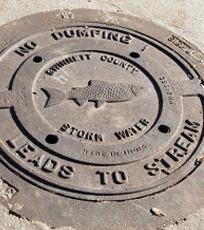Industry Guidelines
Breadcrumb
Page Content Portlet
Industry Guidelines
To assist businesses with compliance, the County has developed several Water Quality Guidelines that list compliant management practices to minimize any potential for water pollution. For more information regarding the industrial inspection program in general, please contact the Stormwater Management Division at 678.376.6826.
Pollutant of Concern
Stormwater Pollution Prevention Plan
A Stormwater Pollution Prevention Plan, or SWPPP, is plan that helps businesses protect stormwater from pollution associated with work on their property. A SWPPP may be required for some industrial businesses. The basic components are a site and activity description, a site map that includes sources of potential pollution, a description of controls to reduce pollutants, and procedures for maintenance and inspection. This will allow the business to prepare for and respond to potential pollutant discharges associated with outdoor activity, and is an excellent tool for training staff on site-specific pollution prevention. For a detailed guide to developing your SWPPP, visit https://www.epa.gov/sites/default/files/2021-03/documents/swppp_guide_industrial_2021_030121.pdf
Outdoor Storage
Storing some materials outdoors is often a solution to the need for space indoors. However, it can also be a source of water pollution. If items stored outside are not properly covered, closed, or contained, rainwater interacting with that storage area could contaminate runoff and contribute to stormwater pollution. This could be considered a violation of the city’s Stormwater Management Ordinance. So be sure to cover outdoor storage, provide secondary containment, and check the condition of materials stored outdoors regularly to prevent stormwater pollution.
Stormwater 101
Storing some materials outdoors is often a solution to the need for space indoors. However, it can also be a source of water pollution. If items stored outside are not properly covered, closed, or contained, rainwater interacting with that storage area could contaminate runoff and contribute to stormwater pollution. This could be considered a violation of the city’s Stormwater Management Ordinance. So be sure to cover outdoor storage, provide secondary containment, and check the condition of materials stored outdoors regularly to prevent stormwater pollution.
Those drains in the parking lot or on the curb are often referred to as “sewers.” While this may be technically true, they are not part of the sanitary sewer system, meaning those drains do not lead to treatment facilities. Stormwater drains direct runoff from parking lots, rooftops, sidewalks, outdoor storage areas, dumpster pads, etc, to underground pipes that discharge into surface waters. This is because the purpose of the stormwater drainage system is primarily to prevent flooding and not to filter the runoff. This means that any pollutants left on the ground or discharged to the drain or the parking lot leading to a drain, can combine with runoff and cause pollution in our waterways. This pollution is easily prevented by having spill response in place, proper outdoor storage, and employee training. The US EPA has great tip sheets for businesses found here: https://www.epa.gov/npdes/stormwater-smart-outreach-tools.

